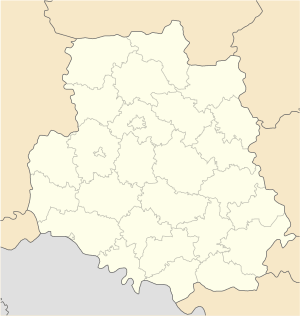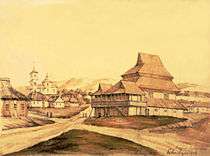Pohrebyshche
Pohrebyshche (Ukrainian: Погребище) is a small town in Vinnytsia Oblast, Ukraine. It is the administrative center of Pohrebyshche Raion (district) in western Ukraine. Pohrebyshche is situated near the sources of the Ros River. Population: 9,765 (2015 est.)[1]
Pohrebyshche Погребище | |
|---|---|
Coat of arms | |
 Pohrebyshche Location of Pohrebyshche  Pohrebyshche Pohrebyshche (Ukraine) | |
| Coordinates: 49°29′0″N 29°16′0″E | |
| Country Oblast Raion | Vinnytsia Oblast Pohrebyshche Raion |
| First mentioned | 12th century as town of Rokitnya. Become a town in 1938, administrative center in 1984 |
| Population (2015)[1] | |
| • Total | 9,765 |
| Postal code | 22200 |
| Area code(s) | +380 +486 |
Names
Pohrebyshche is also known as Polish: Pohrebyszcze, Russian: Погребище Pogrebischtsche or Pogrebishchye or Pogrebishche, Yiddish: פרהאבישטא Prhobisht.
History
The town is very old and origin of its name is not clear. Pohreb means a big cellar in Ukrainian. On the other hand, Pohrebaty can be interpreted as to perform a burial. According to a legend, put down by Ukrainian ethnographer Pokhilevich, before the Mongol invasion of Rus, during the times of Kyiv the town was called Rokitnya. Mongols leveled the town leaving only the cellars.
The first time the town was mentioned in written sources was in 1148. For many years it belonged to the Kiev Voivodeship within the Polish–Lithuanian Commonwealth. During the Khmelnytsky Uprising (1648–1657) and in the later wars of the 17th century the town was destroyed by fire and its inhabitants massacred by foreign armies several times. Only around 1720 did a more fortunate period for Pohrebyshche begin.[2] In 1795 the town became part of the Russian Empire.

People
Countess Ewelina Hańska (Rzewuska) a Polish noblewoman (szlachcianka) was born January 6, 1805 in Pohrebyshche. Ewelina was the sister of Henryk Rzewuski. She was married to Wacław Hański, a landowning noble, who was about twenty years older than she was. After his death she married the French novelist Honoré de Balzac in 1850.
The town had a substantial Jewish population. The Jews were murdered during the Second World War by the Nazis and local fascists. In 1928, the large synagogue was converted into a Workman's Club.[3] It was destroyed during the war.
Gallery
 City hall
City hall Church in Pohrebyshche
Church in Pohrebyshche Chapel near the town
Chapel near the town World War II memorial
World War II memorial
Other nearby communities
- Vinnytsia 40 miles (64 km) ENE
- Plyskiv 8 miles (13 km) S
- Borshchahovka 12 miles (19 km) E
- Ruzhyn 16 miles (26 km) N
- Belilovka 17 miles (27 km) NW
- Samhorodok 19 miles (31 km) W
- Tetiiv 19 miles (31 km) ESE
- Lypovets 20 miles (32 km) SSW
- Zhivotivka 21 miles (34 km) SE
- Vakhnovka 22 miles (35 km) WSW
- Skvyra 25 miles (40 km) NE
- Koziatyn 25 miles (40 km) NW
- Illintsi 25 miles (40 km) S
- Pavoloch 28 miles (45 km) NNE
- Volodarka 29 miles (47 km) E
- Balabanivka 30 miles (48 km) SSE
- Berdychiv 42 miles (68 km) SE
References
- "Чисельність наявного населення України (Actual population of Ukraine)" (PDF) (in Ukrainian). State Statistics Service of Ukraine. Retrieved 1 July 2016.
- Maria and Kazimierz Piechotka: Heaven's Gates. Wooden synagogues in the territories of the former Rzeczpospolita of Poland and Lithuania. Seite 453. Polish Institute of World Art Studies & POLIN Museum of the History of Polish Jews, Warschau 2015, ISBN 978-83-942048-6-0. History of town.
- "Two More Synagogues in Russia Are Converted into Workmen's Clubs". Feb 27, 1928. Retrieved Apr 3, 2020.